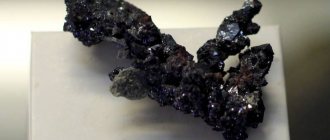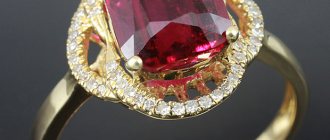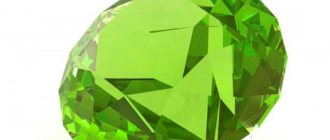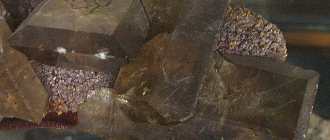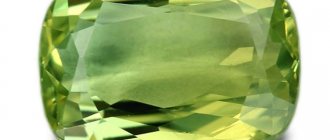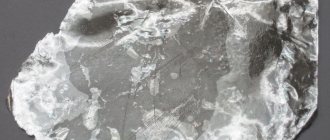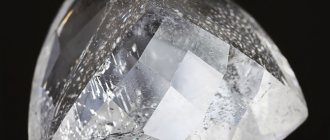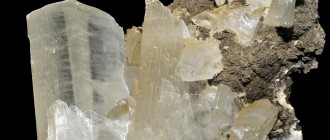In Greek, the term "spodios" means "ashy", from which the name of the mineral spodumene comes, indicating its ash-gray color. In general, its color range also includes shades of pale yellowish-gray up to colorless specimens. Popular colored subspecies are also known for spodumene: light purple or pink kunzites and light green giddenites. All of them are transparent and translucent, have a glassy sheen and perfect cleavage. When heated they are destroyed.
Spodumene deposits
Spodumenes are commonly found in granitic pegmatite deposits.
Large crystals are often combined with quartz and tourmaline. At first, kunzites were even confused with the latter. — Advertising —
Today, industrial suppliers of spodumene are the USA, Norway, Brazil, Afghanistan, Austria and Russia.
History of spodumene
Spodumene belongs to the lithium-containing pyroxenes.
Its name is of Greek origin and goes back to the word “spodumenos”, which translates as “ashy”. When heated, the initially gray mineral transforms into a substance resembling ash. Spodumene and its subspecies began to be used as jewelry stones from the end of the 19th century, but they were not very popular, as they turned out to be difficult to process.
There are many known deposits for this mineral, where it occurs in the form of large blocks, but it is difficult to cut it, since it is quite fragile. Today, spodumene is used for carving, and kunzites and giddenites are used in jewelry.
Jewelry production
There are quite a lot of stone deposits in nature. Jewelers make a wide range of products containing spodumene inserts. The rather fragile stone is processed by professionals. Sometimes reworking a crystal can cause cracks to appear on its surface. Incorrect cutting may result in loss of color. The thickness of the insert has a direct impact on the color saturation of the mineral. Scientific and technical direction
In the field of science and technology, spodumene becomes the raw material from which lithium is extracted. The mineral becomes the starting material in the production of glass products. In addition, batteries and pyrotechnic devices are created on the basis of crystals. The mineral also finds application in nuclear energy and medicine.
Record spodumene
Natural spodumene often appears in huge lumps.
The largest crystal ever found in the United States weighed 90 tons, had a length of 12.5 meters and a width of 2 meters. The largest faceted yellowish-brown spodumene weighed 1,800 carats and is today kept in the Royal Ontario Museum (Canada), and the largest carved spodumene (height 137 mm, weight 6000 carats) belongs to a private collector from the USA. — Advertising —
The British Natural Science Museum owns a giant cut kunzite weighing 61.7 carats. The Smithsonian Institution (Washington) stores three Brazilian samples of this mineral, 880, 663 and 297 carats each, and triphan weighing 327 carats. Treated kunzites with a “cat’s eye” effect weighing 35 and 113 carats are also known.
Physicochemical characteristics of spodumene
Spodumene by its chemical nature is a complex lithium aluminosilicate.
The hardness of the mineral on the Mohs scale is 6.5-7, specific gravity 3.2 g/cm3, that is, it is brittle. Spodumenes form long-prismatic crystals or flattened, tapering crystals without end faces. The edges of the crystals are shaded and fissured.
The crystals have a monoclinic system, transparent or translucent, with perfect cleavage, uneven, conchoidal fracture, glassy or pearlescent luster. They are colorless or greenish-white, grayish-white, yellowish-green, emerald green, yellow, lilac, violet. There are also two-color specimens. They have pronounced pleochroism, yellow, orange or pink luminescence.
Spodumene is not soluble in acids.
Spodumenes are found together with quartz, albite, tourmaline, microcline, tantalite, pollucite, petalite, eucryptite, lepidolite, and beryl.
Types of spodumene
Several subspecies are known for spodumene:
- kunzites - contain manganese, colored pink, purple, violet, were first found at the end of the 19th century. At first they were confused with tourmalines, but later scientists determined that kunzite is a type of spodumene.
- Hiddenites - colored emerald green and bluish green, which is due to the fact that their crystals contain chromium or vanadium, which replace aluminum. The first examples of this bluish-green stone were found in the USA in the 19th century. They were discovered by geologist W.E. Gidden, after whom the mineral was later named.
- Trifana is a subspecies of spodumene with transparent, colorless, yellow or yellow-green crystals.
Stone cost
The price of spodumene depends on the color and form in which it is sold. The cheapest ones are unprocessed samples for magical purposes (or making jewelry yourself).
For example, trifan from Afghanistan measuring about 4x2 cm will cost 1,500 rubles, and giddenite of the same size from Brazil will cost less than 1,000 rubles. The most expensive purchase will be kunzite - a pebble even a few centimeters long costs about 10,000 rubles.
Prices for jewelry in a silver frame start from a couple of thousand rubles, and in gold they reach several tens of thousands.
Applications for spodumene
Most of the mined spodumene is used in the production of lithium metal.
It has also found application in the production of various types of glass. Spodumene crystals of unique shapes and shades are a valuable collection material; in addition, they are used in jewelry as faceted inserts.
Unfortunately, due to the difficulty of cutting and polishing the stone, its fragility and ability to lose its color when exposed to bright sun, jewelers rarely use it.
Form of being in nature
The appearance of crystals . The crystals are prismatic, often flattened along a (100), with vertical shading. Well-formed crystals are rare. Large crystals usually have deep grooves and projections. Some crystals are deformed; individual faces and planes (100) are sometimes curved. Under a microscope, in the (100) plane, an alternation of deformed and undeformed blocks, almost parallel to (001), is visible. The plank appearance of spodumene crystals flattened along (100) is explained by sliding along the individual (100) plane.
Doubles by (100), 2-4 individuals are distinguishable, rarely more. Intergrowths of spodumene with quartz formed along it are known; spodumene intergrown with quartz may also be a product of petalite decomposition.
Aggregates. Crystals (from fractions of a millimeter to 15 m), grains, their intergrowths, rarely radial, lamellar-columnar, shell-like and fibrous aggregates;
pseudomorphs and oriented intergrowths with quartz on petalite.
Artificial spodumene
Synthetic spodumene itself is not currently produced, but it is often refined. For example, colorless or lightly colored specimens are exposed to gamma radiation, after which they acquire a pink, yellowish or greenish color. With neutron irradiation, it is possible to obtain stones of brown-orange or greenish-yellow color. When heated to 500°C, spodumene of any color loses color.
Therapeutic effect
Lithotherapists say: the main significance of the stone is its energetic power. It can affect a person’s mental and physical health:
- The mineral acts as a sedative: calms the nerves, neutralizes depression, and promotes sound sleep.
- Solves problems of the blood and cardiovascular system.
- Relieves headaches and joint pain.
- Inhibits the development of acute respiratory infections, acute respiratory viral infections, and other seasonal ailments.
- Helps ladies get pregnant and give birth to a healthy child (you need to wear a ring on your main hand).
The mineral strengthens the immune system and restores the body. Its medicinal properties are especially useful after operations or serious illness.
How to care for spodumene
Spodumene, as well as its subspecies, must be protected from prolonged exposure to bright sun and heat, since in such conditions the gem loses its natural color.
In addition, the mineral is quite fragile, it is easy to scratch and damage, so you need to wear jewelry with spodumene carefully, and store it in separate boxes with soft walls or in soft bags. To clean products with this stone, cool water and a soft cloth are used, with which they are then wiped dry and polished.
Properties
Natural spodumene has energy that is successfully used both in lithotherapy and in magic.
Magical
According to esotericists, spodumene has the following magical properties:
- protects against any negative influences;
- protects a person from damage, the evil eye, accidents, enemies;
- enhances intuition;
- increases intelligence;
- makes the owner softer, more educated, more loyal to others;
- attracts good luck, financial well-being, happiness in your personal life;
- fills a person with harmony and tranquility.
It is believed that spodumene is able to recognize lies, intrigue, and dubious deals. In this case, the mineral fades a little, which makes the owner aware of a hypothetical danger.
Medicinal
The energetic power of spodumene in the field of lithotherapy is used mainly to calm and strengthen the immune system. However, lithotherapists have identified other beneficial properties:
- calms the nervous system, eliminates the effects of stress and depression, improves sleep;
- relieves headaches;
- has a positive effect on the female reproductive system;
- stabilizes the functioning of the heart and hematopoietic organs;
- promotes speedy recovery after complex operations and illnesses.
It should be understood that treatment with natural minerals belongs to the field of alternative medicine, and therefore, first of all (if suspicious symptoms are identified), you must immediately consult a qualified doctor, and only then resort to lithotherapy.
Prices for spodumene products
The most commonly used varieties of spodumene in jewelry are kunzite and giddenite.
Kunzites have the same price as amethysts and are valued at $8 to $15 per carat. Increasing the size of a stone does not greatly affect its price, which is more determined by its clarity and color. For example, a pale-colored 10-carat kunzite specimen is valued at $150. The cost of kunzite beads ranges from $100 to $200, and solid threads are very rare due to the fragility and difficulty of processing the stone.
The price of kunzite becomes significantly higher if it has a rich color. The most expensive stones are those of violet and violet-red color, as thick as amethyst; samples of pink and lilac shades are valued less. Bright kunzites start at $500 per carat. Pink or lilac stone can be purchased from $80 per carat.
Giddenite weighing 1 carat is estimated at $1,000, since only one deposit is known for it, and processing the stone is difficult due to its fragility.
Description and varieties of mineral
The gem belongs to the group of litho-containing pyroxenes. In nature, it occurs in the form of drusen of various colors. When found, spodumene is associated with the following breeds:
- tourmaline;
- quartz;
- beryl;
- magnetite;
- albite.
Crystalline formations almost always have many defects and cracks, but do not contain other rocks or other inclusions. The minerals are popular among jewelers due to their unusual shades due to the presence of ion impurities.
Varieties of spodumene by color:
- Giddenite is a bluish-green crystal discovered in 1879. The higher the content of chromium and vanadium, the brighter and more saturated the color of the mineral.
- Kunzite is a stone with manganese in its chemical composition, first discovered in 1899. The color of the mineral varies depending on the amount of the substance from smoky pink to purple.
- The light stone is triphan, the color of which is determined by the amount of iron in the structure of the stone. The mineral occurs in nature, ranging from colorless druses to bright yellow ones.
- Nuristanite is a rare rock of blue or bright blue color, mined mainly in Nuristan, a provincial town in Afghanistan.
View this post on Instagram
Post from JEWELERY BLOGGER LYUBA | STYLE (@nuzna_luba) May 20, 2019 at 6:31 PDT
The photo shows a faceted triphan:
View this post on Instagram
Publication from Cutting Workshop “DESCUT.RU” (@descut.ru) December 22, 2015 at 8:35 PST
Prices for spodumene jewelry depend on the metal in the frame and the type of minerals. Approximate cost:
- gold earrings with triphan – from 10,000 rubles;
- silver bracelet with giddenite – about 15,000 rubles;
- necklace with kunzite – 50,000 rubles.
To identify counterfeit spodumene in a store, pay attention to its distinctive features:
- muted tone;
- when rotated, the color changes intensity;
- longitudinal hatching is visible on the edges;
- crystals luminesce in sunlight.
See what the processed stone looks like:
Interesting facts about spodumene
- A unique piece of spodumene jewelry is a pearl necklace with cut spodumene weighing 396 carats, and a kunzite ring weighing 52 carats is also known, surrounded by 104 diamonds worth 2.63 carats. Both decorations are kept in the Smithsonian Institution (USA).
- Using synthetic hydrothermal spodumene-hiddenite, imitations of emerald are made, but it is quite easy to distinguish it, since spodumene has a very different crystal structure, which can be seen under a microscope and even with a magnifying glass. In addition, spodumene reveals its obvious pleochroism.
Who is suitable according to their zodiac sign?
According to astrologers, spodumene is the stone of people born under the signs of the elements of Earth and Fire:
- Leo will feel inner strength and become more restrained and reasonable.
- Aries will be able to achieve success in his career - luck will always be with him.
- Sagittarius will rely more on reason rather than feelings when making decisions.
- With the help of a stone, Capricorn will strengthen his hard work, responsiveness and responsibility.
- The mineral will help Taurus develop, pursue their goals and find a way out of difficult situations.
- Virgo will get rid of doubts, learn to think clearly, and make the right decisions.
